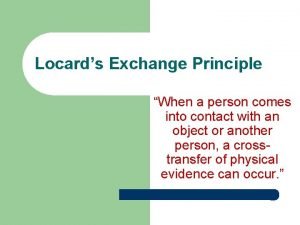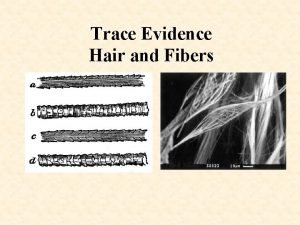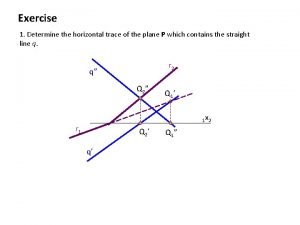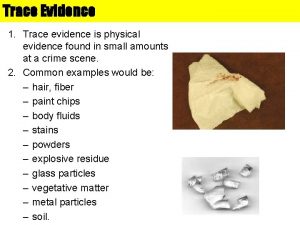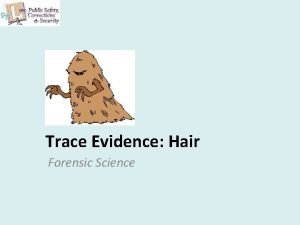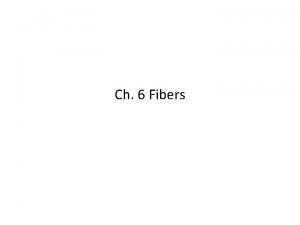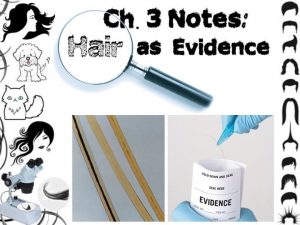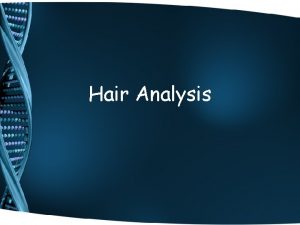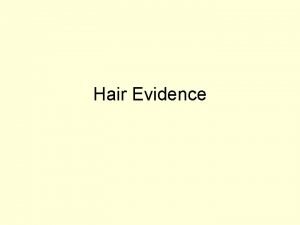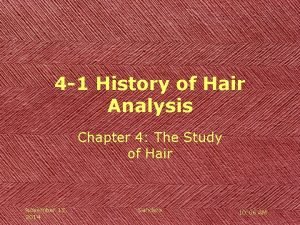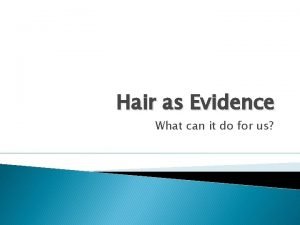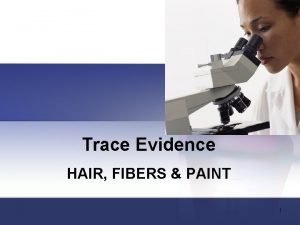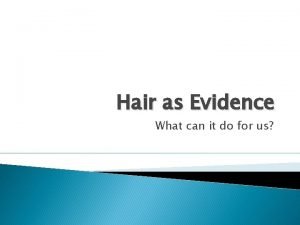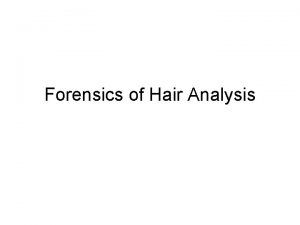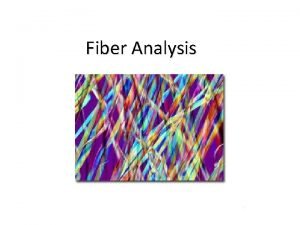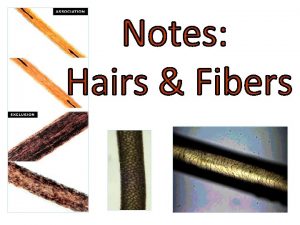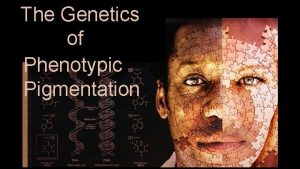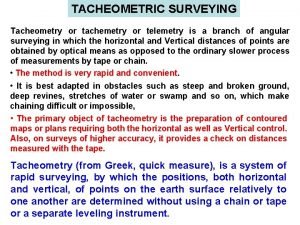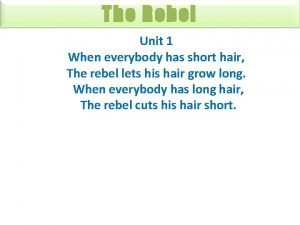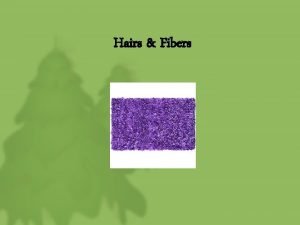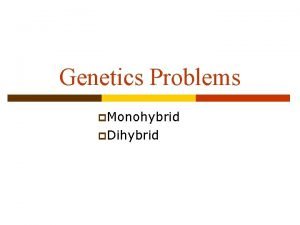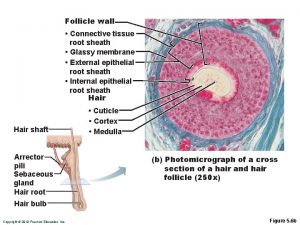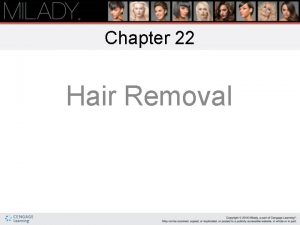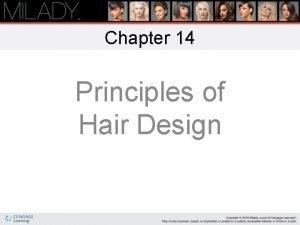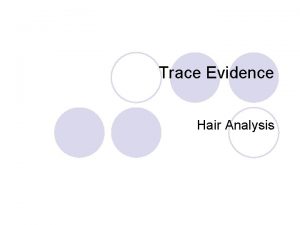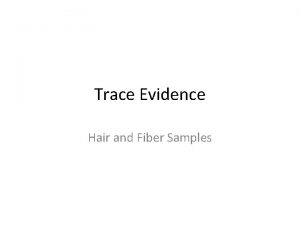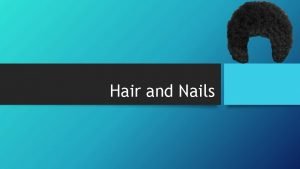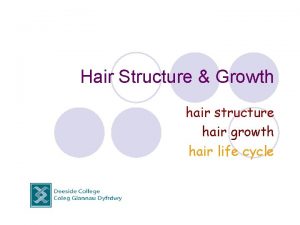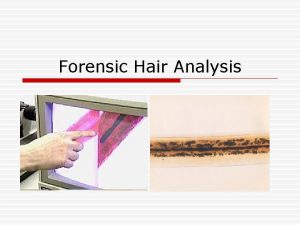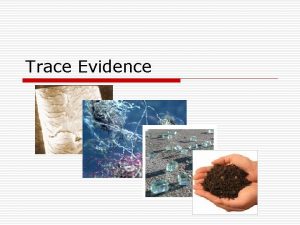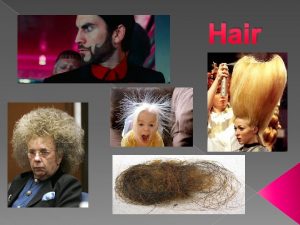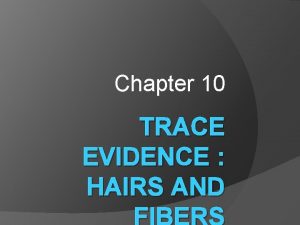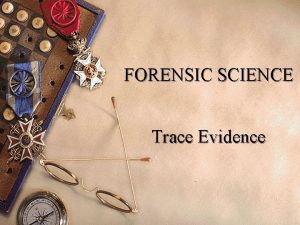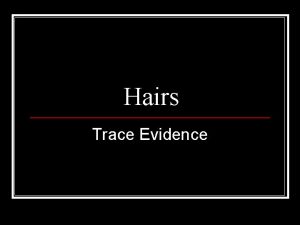TRACE ELEMENTS HAIR AS EVIDENCE Review of Locards











































- Slides: 43

TRACE ELEMENTS: HAIR AS EVIDENCE

Review of Locard’s Principle Edmond Locard established the Exchange Principle which states that when two objects come into contact with each other material will be exchanged. This material is generally collected from the exchange object. For example, a hair collected off of a chair. This type of evidence is called trace evidence.

Trace Evidence Trace evidence is a category of physical evidence. Examples of trace evidence include: hairs, fibers, fingerprints, paint chips, soil, sand, gunshot residue and dust.

Hair as Evidence Human hair is one of the most frequently found pieces of evidence at the scene of a violent crime. It can provide a link between the criminal and the act. From hair one can determine: u u u Human or animal Race Origin Manner in which hair was removed Treated hair Drugs ingested

The First Determination for Hair Evidence: Human or Animal? In order to make the determination human vs. animal, an understanding of the morphology of hair and types of hair is essential.

Hair Morphology The Study of Structure and Form Parts of the hair u u u Shaft--part of the hair that sticks out of the skin Root--lies below the epidermis Follicle—organ from which the hair grows (source of DNA)

A Pencil Analogy for the Three Layers of Hair

Hair Cuticle The cuticle is the outermost layer of hair which is covered with scales. Scales always point toward the tip of the hair. These scales differ between species of animals and are named based on their appearance.

Scale Types Mosaic Chevron

Rabbit- Chevron Scales

Cat- Mosaic Scales

Scale Types (cont) Imbricate Petal

Human- Imbricate Scales

Dog- Petal Scales

Hair Cortex The cortex has two major components: u Melanin--pigment granules that give hair its color u Cortical fusi--air spaces, usually found near the root but may be found throughout the hair shaft

Hair Medulla The medulla is the central canal running through the hair core. A medulla is always present. The medulla comes in different types and patterns. Types: u. Continuous u. Intermittent or interrupted u. Fragmented u. Absent--not present

Hair Medulla Patterns Uniserial Multiserial Vacuolated Lattice Amorphous (without a distinct pattern)

Medullary Index The index measures the diameter of the medulla relative to the diameter of the hair shaft. Medullary Index for human hair is generally less than 1/3. For animal hair, it is usually greater than 1/2.

A human medulla may be classified as absent, fragmental, interrupted, or continuous.

A Cat Medulla is uniserial and generally described as a string of pearls

A Rabbit medulla is different depending on where the hair grows on the rabbit. Both of these hairs are from the same rabbit. One is multi-serial and the other two are uniserial.

A Cow medulla has an amorphous pattern

A Deer Medulla has a lattice pattern

Hair Root The hair root is the end in the follicle from which the hair grows. The length of hair grows 0. 5 mm per day or 1 centimeter per month. There are three phases for hair: Anagen Catagen Telogen

Anagen Phase The anagen phase is the growing phase. This phase may last from 2 years to 6 years for a given hair. Approximately 85% of hair is in the growing phase at any one time. During this phase the hair is at maximum depth in the skin.

Catagen Phase The catagen phase is the transitional phase. This phase lasts one to two weeks. During this stage, the follicle shrinks to 1/6 of its normal length. The dermal papilla breaks away to rest below. Blood supply is cut off and the hair stops growing.

Telogen Phase The telogen phase is the resting phase. This phase lasts about 100 days for scalp hair. At this time the hair is completely at rest. Anywhere from 25100 telogen hairs are normally shed each day.

The Hair Root During each of the hair phases, the root has a different shape. During the anagen phase the root has a flame shape. During the catagen phase the root begins to elongate and get thinner. During the telogen phase the root becomes club-shaped and the root hardens.

If a hair is forcibly removed… Hairs shed normally during the telogen phase so the root is not effected when the hair is shed. However, during the anagen phase, the root is bulb shaped and attached to the follicle. A hair would have to be forcibly removed during this phase. Therefore, the root will show signs of trauma. This is a very important clue in violent crimes.

Anagen Hair Root from a forcibly removed hair. The root shows signs of the trauma.

Telogen Hair Root Naturally shed hairs display club shaped root. The root does not have any signs of trauma.

Human hair roots are different from animal hair roots.

Cat Hair Root

Squirrel Whisker Root

Summary of Human vs. Animal In order to determine if a hair is human or animal: 1. Compare the hair scales 2. Compare the medullary index 3. Compare the medullary shape/pattern 4. Compared the hair root

If the hair is human… Once the determination is made that the hair is human then race, origin and hair treatments can be decided.

Determination of Race African-American hairs are kinky, containing dense, unevenly distributed pigments (left) Caucasian hairs are straight or wavy with very fine to coarse pigments that are more evenly distributed (right)

Origin of Human Hair u u Scalp hair shows little diameter variation and more uniform distribution of pigment color. Beard hair is coarse and has blunt tips. u Pubic hair is short and curly, with wide variation in shaft diameter, or buckling, and has a continuous medulla.

Colored Hair Dyed hair – presence of “color” in cuticle and throughout cortex Bleaching – removes natural pigment and gives yellowish tint Dyed and bleached hair can be determined through microscopic examination.

Ingested Drugs 5 -10 days after the drug is ingested, it will be present in the hair. The drug becomes a part of the hair may be detected up to 2 years. It takes at least 50 scalp hairs for an accurate test.

Other Types of Identification Age - only infant’s hair can be determined because it is so fine. u Sex- sex cannot be determined from hair. u u u Manner- can determine if hair was forcibly removed. The follicle tag will still be attached. Individualization- through positive microscopic comparison and mitochondrial DNA analysis a link from questioned hair to standard hair can be proven.

Collection of Hair Evidence Questioned hairs given to the lab for analysis must be accompanied by an adequate number of control samples. – – – from victim possible suspects others who may have deposited hair at the scene The Control Sample should include: – – – 50 full-length hairs from all areas of scalp 24 full-length pubic hairs The full hair is needed so the control samples will be pulled out or cut as close as possible to the skin.

Bill Cosby’s son Ennis Cosby was stranded on the side of a highway due to a flat tire. As Ennis waited for help, Mikail Markhasev robbed and murdered him. The police found the murder weapon wrapped in a blue cap. Hair was also recovered from the cap. Markhasev was convicted on the murder based on the hair evidence. He later confessed to the crime.
 A folded paper used to hold trace evidence
A folded paper used to hold trace evidence Hair growth
Hair growth Vertical trace and horizontal trace
Vertical trace and horizontal trace Examples of trace evidence
Examples of trace evidence Trace evidence examples
Trace evidence examples Soil trace evidence
Soil trace evidence Line/strip search pattern
Line/strip search pattern Isodiametric hair
Isodiametric hair Trace elements in seawater
Trace elements in seawater Primary evidence vs secondary evidence
Primary evidence vs secondary evidence Primary evidence vs secondary evidence
Primary evidence vs secondary evidence Primary evidence vs secondary evidence
Primary evidence vs secondary evidence Primary evidence vs secondary evidence
Primary evidence vs secondary evidence Jobs vancouver
Jobs vancouver Why are fibers class evidence
Why are fibers class evidence Class evidence vs individual evidence
Class evidence vs individual evidence Class evidence can have probative value.
Class evidence can have probative value. A pair of latex gloves was found at a crime scene
A pair of latex gloves was found at a crime scene The absence of evidence is not evidence of absence meaning
The absence of evidence is not evidence of absence meaning Why is fiber class evidence
Why is fiber class evidence Negroid hair under microscope
Negroid hair under microscope Medulla pattern with one unbroken line of color
Medulla pattern with one unbroken line of color What makes hair evidence valuable?
What makes hair evidence valuable? Is hair direct or circumstantial evidence
Is hair direct or circumstantial evidence Is hair class or individual evidence
Is hair class or individual evidence Medulla pattern with one unbroken line of color
Medulla pattern with one unbroken line of color Mongoloid
Mongoloid What are the possible limitations of using hair as evidence
What are the possible limitations of using hair as evidence Head hairs and pubic hairs exhibit a greater range of
Head hairs and pubic hairs exhibit a greater range of Fiber definition forensics
Fiber definition forensics Hair cuticle patterns
Hair cuticle patterns Mongoloid
Mongoloid Dark hair and blonde hair parents
Dark hair and blonde hair parents Uses of tacheometry
Uses of tacheometry When everybody has short hair poem
When everybody has short hair poem Hair grows in diagonal tubes called hair
Hair grows in diagonal tubes called hair Medulla pearl shape
Medulla pearl shape Heterozygous short-hair x heterozygous short-hair
Heterozygous short-hair x heterozygous short-hair Glassy membrane of hair follicle
Glassy membrane of hair follicle The two primary parts of hair are the hair fiber and the
The two primary parts of hair are the hair fiber and the Section 15-2 review theories of evolution
Section 15-2 review theories of evolution Milady chapter 22 review questions
Milady chapter 22 review questions Principles of hair design chapter 14
Principles of hair design chapter 14 Physical evidence and the servicescape
Physical evidence and the servicescape
